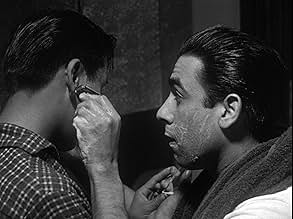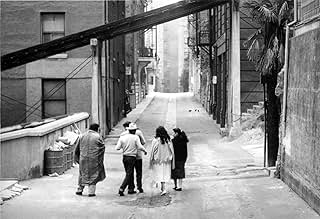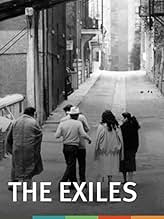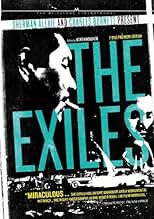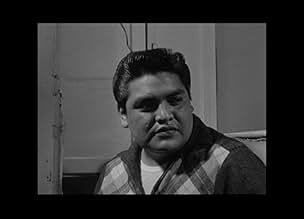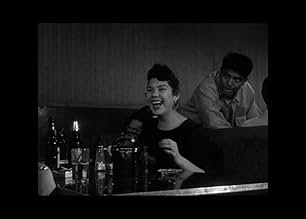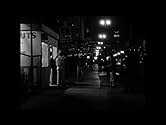NOTE IMDb
6,6/10
1,5 k
MA NOTE
Il suit une famille d'Amérindiens vivant dans la Cité des Anges.Il suit une famille d'Amérindiens vivant dans la Cité des Anges.Il suit une famille d'Amérindiens vivant dans la Cité des Anges.
- Réalisation
- Scénario
- Casting principal
- Récompenses
- 1 victoire au total
Tom Reynolds
- Tommy
- (as Tommy Reynolds)
Avis à la une
The premise is simple-we follow a group of young, modern day Native American men and women in Los Angeles over 24 hours. We experience their daily rituals, conflicts, and pleasures, and, for the most part, I found this rather simple film to be highly interesting. Although it remains virtually plot less throughout, there are some moments of conflict and surprising intensity that save it from being "boring" or overly mundane. The tragedies as well as the comedies of life are explored, as personalities, feelings, and opinions are revealed and studied.
The highlights of the film are the dazzlingly beautiful voice over sequences, in which a random character will voice their perspective on their way of life or their friends or their hopes and aspirations, and so on. They transform the every man into a wise and lovable poet. We understand and learn about our characters more and more not only through their subtle actions, but also their words and ways of communicating.
However, there are moments of boredom here. I think this movie would have worked better as a lengthy short film that would be, say, 35-40 minutes long. That would be perfect. Either that or a little bit more conflict or humor or just flat out interesting events.
The highlights of the film are the dazzlingly beautiful voice over sequences, in which a random character will voice their perspective on their way of life or their friends or their hopes and aspirations, and so on. They transform the every man into a wise and lovable poet. We understand and learn about our characters more and more not only through their subtle actions, but also their words and ways of communicating.
However, there are moments of boredom here. I think this movie would have worked better as a lengthy short film that would be, say, 35-40 minutes long. That would be perfect. Either that or a little bit more conflict or humor or just flat out interesting events.
This was one of the first films to deal with the contemporary lives of Native Americans. It's still one of the very few pieces to deal with the Native urban diaspora, in this case in the no-longer existing LA neighborhood of Bunker Hill, in 1961.
More broadly, "Exiles" is a film about displacement, and finding oneself in a state of displacement, of having one's truest self be the displaced self. It focuses on a young, married couple who hardly see each other. The husband is out cavorting and fighting with other young quasi- hooligans. The wife is mostly alone, or abandoned at the cinema. The only scene where we sense that she is bonding with anybody is when she is in bed, in an officially asexual way, with a girlfriend.
As an empathetic depiction of the alienation that occurs when people are divorced from their (essentially extinct) culture, one cannot help but admire the film. Yet, I was left with the troubling sense that its depiction of characters driven to cling to each other based on the most basic similarities, such as tribe,race, and, perhaps most importantly in the eyes of the filmmakers, gender, was decidedly heteronormative. I wouldn't go so far as to call the film homophobic. The only brazenly gay characters, a couple of dudes dancing in a "straight" bar, are depicted in a neutral light. Yet, the isolation of man from woman, and "debauched" same-sex mingling are depicted as the prime symptoms of alienation under colonialism and capitalism. This attitude was all too common amid leftists in the era that the film was made.
For contemporary viewers, perhaps the most rewarding thing about The Exiles is its luscious black and white cinematography of the now destroyed Bunker Hill district of Los Angeles. As a documentary extra on the DVD further attests, Bunker Hill was a dynamic, multinational district that was home to immigrant families and retired professionals. Soon after this movie was completed, the neighborhood was bulldozed in an attempt to "improve" LA. In this way, the film seems like a depiction of two fallen cultures: the exiles of crushed Native American culture inhabiting an urban landscape that is itself now only a celluloid ghost.
More broadly, "Exiles" is a film about displacement, and finding oneself in a state of displacement, of having one's truest self be the displaced self. It focuses on a young, married couple who hardly see each other. The husband is out cavorting and fighting with other young quasi- hooligans. The wife is mostly alone, or abandoned at the cinema. The only scene where we sense that she is bonding with anybody is when she is in bed, in an officially asexual way, with a girlfriend.
As an empathetic depiction of the alienation that occurs when people are divorced from their (essentially extinct) culture, one cannot help but admire the film. Yet, I was left with the troubling sense that its depiction of characters driven to cling to each other based on the most basic similarities, such as tribe,race, and, perhaps most importantly in the eyes of the filmmakers, gender, was decidedly heteronormative. I wouldn't go so far as to call the film homophobic. The only brazenly gay characters, a couple of dudes dancing in a "straight" bar, are depicted in a neutral light. Yet, the isolation of man from woman, and "debauched" same-sex mingling are depicted as the prime symptoms of alienation under colonialism and capitalism. This attitude was all too common amid leftists in the era that the film was made.
For contemporary viewers, perhaps the most rewarding thing about The Exiles is its luscious black and white cinematography of the now destroyed Bunker Hill district of Los Angeles. As a documentary extra on the DVD further attests, Bunker Hill was a dynamic, multinational district that was home to immigrant families and retired professionals. Soon after this movie was completed, the neighborhood was bulldozed in an attempt to "improve" LA. In this way, the film seems like a depiction of two fallen cultures: the exiles of crushed Native American culture inhabiting an urban landscape that is itself now only a celluloid ghost.
Astonishing slice of cinema verite at a time when young filmmakers were trying to break the Hollywood habit in favor of the real world. The 70 minutes are not entertaining; however, they do fascinate. It's a nighttime of boozing carousal for several young Indian men amid the neon jungle of downtown LA. The camera tracks their aimless wanderings and endless drinking from one seedy venue to the next. It's LA like you've seldom seen it—a down-and-outers look at unvarnished urban decay. The faces too are fascinating, not like the usual Hollywood Indian or crowd scene extras.
It's a disturbing look, slow to accumulate until the poignant final shot. These are truly lost people, caught between two incomplete worlds-- the urban jungle of the white man and the captive reservation of the Indian. The men seem to treat most everything as a joke, perhaps a way of denying the dead-end reality of their lives. Ironically, they appear now to be strangers in their own land. It's the young Indian woman Yvonne, however, who's likely to evoke audience sympathy. It's she who dreams (her inner thoughts vocalized in voice-over) of a family and something like a normal life. But, the men in her life are truly lost, so her hopes appear doomed as well. Seeing this document may help viewers better understand the controversial American Indian Movement (AIM) of the 1970's.
Apparently, the project spanned several years of interrupted funding. Thus, the film has to be an artistic commitment of a high order on the part of filmmaker MacKenzie. Did he hope for a commercial release. A story and technique like this would seem to hold little promise of that. Did he hope for art house distribution and an appeal to the intelligentsia. Whatever the motivation, he's produced a document of lasting social value, and thanks be to TMC for bringing MacKenzie's achievement to today's audiences
It's a disturbing look, slow to accumulate until the poignant final shot. These are truly lost people, caught between two incomplete worlds-- the urban jungle of the white man and the captive reservation of the Indian. The men seem to treat most everything as a joke, perhaps a way of denying the dead-end reality of their lives. Ironically, they appear now to be strangers in their own land. It's the young Indian woman Yvonne, however, who's likely to evoke audience sympathy. It's she who dreams (her inner thoughts vocalized in voice-over) of a family and something like a normal life. But, the men in her life are truly lost, so her hopes appear doomed as well. Seeing this document may help viewers better understand the controversial American Indian Movement (AIM) of the 1970's.
Apparently, the project spanned several years of interrupted funding. Thus, the film has to be an artistic commitment of a high order on the part of filmmaker MacKenzie. Did he hope for a commercial release. A story and technique like this would seem to hold little promise of that. Did he hope for art house distribution and an appeal to the intelligentsia. Whatever the motivation, he's produced a document of lasting social value, and thanks be to TMC for bringing MacKenzie's achievement to today's audiences
The Exiles by Kent Mackenzie, USA (Documentary). A 1961 documentary chronicling a day in the life of a group of twenty-something Native Americans who left reservation life in the 1950s to live in LA.
A unique and powerful film, blending storytelling with documentation. Mackenzie constructed a narrative about one day in the life of three main characters - a pregnant young woman (Yvonne), the father (Homer), and a man about town (Tommy). Both men are profound alcoholics, and the woman seems stunned by the circumstances of her life though hopeful for the future of her child.
The film opens with portraits from Edward Sheriff Curtis's monumental North American Indian, which I recommend as a starting place. Mackenzie has a sharp eye for cultural details - check out the Grand Hotel mattress in Yvonne and Homer's apartment, as well as the magazines, comics, advertisements, toys, and street scenes.
The story develops via voiceovers by Yvonne, Homer, and Tommy - and an amazing middle sequence from the rez, with generous doses of native language and music.
This is a must-see movie for anyone interested in social work, indigenous peoples, or the dark side of American culture. Never boring for any viewer.
A unique and powerful film, blending storytelling with documentation. Mackenzie constructed a narrative about one day in the life of three main characters - a pregnant young woman (Yvonne), the father (Homer), and a man about town (Tommy). Both men are profound alcoholics, and the woman seems stunned by the circumstances of her life though hopeful for the future of her child.
The film opens with portraits from Edward Sheriff Curtis's monumental North American Indian, which I recommend as a starting place. Mackenzie has a sharp eye for cultural details - check out the Grand Hotel mattress in Yvonne and Homer's apartment, as well as the magazines, comics, advertisements, toys, and street scenes.
The story develops via voiceovers by Yvonne, Homer, and Tommy - and an amazing middle sequence from the rez, with generous doses of native language and music.
This is a must-see movie for anyone interested in social work, indigenous peoples, or the dark side of American culture. Never boring for any viewer.
There are some real classics out there but you have to search with information from those who are in the know concerning great films and great filmmakers.
Kent MacKenzie gives us a 24-hour slice of the life of a young couple who moved from the reservation to Los Angeles in the 50s. I can go back and appreciate this now that I am older; much more than I would have at 11.
It is not a pretty picture. The men didn't work and spent their time drinking and gambling and hanging out. The wives were expected to feed them, clean their clothing, and give them what money they had.
There was a real fatalism in their voices and attitudes. Life was a party, and if things didn't work out, you could always go back to the reservation. Doing time? No problem, I do it outside, so I can do it inside.
Added to the National Film Registry this year, it is a slice of life that shows no promise.
Kent MacKenzie gives us a 24-hour slice of the life of a young couple who moved from the reservation to Los Angeles in the 50s. I can go back and appreciate this now that I am older; much more than I would have at 11.
It is not a pretty picture. The men didn't work and spent their time drinking and gambling and hanging out. The wives were expected to feed them, clean their clothing, and give them what money they had.
There was a real fatalism in their voices and attitudes. Life was a party, and if things didn't work out, you could always go back to the reservation. Doing time? No problem, I do it outside, so I can do it inside.
Added to the National Film Registry this year, it is a slice of life that shows no promise.
Le saviez-vous
- AnecdotesKent Mackenzie borrowed equipment from industrial film makers Parthenon Pictures and used the unused "ends" of thousand-foot reels of 35mm film, according to an article in the 12 March 1961 edition of the New York Times.
- GaffesIn a scene where an older man is heard singing and playing an instrument under a tree, he is not doing corresponding actions in a long-shot.
- ConnexionsFeatured in Los Angeles Plays Itself (2003)
Meilleurs choix
Connectez-vous pour évaluer et suivre la liste de favoris afin de recevoir des recommandations personnalisées
- How long is The Exiles?Alimenté par Alexa
Détails
Box-office
- Budget
- 539 $US (estimé)
- Montant brut aux États-Unis et au Canada
- 30 945 $US
- Week-end de sortie aux États-Unis et au Canada
- 8 448 $US
- 13 juil. 2008
- Montant brut mondial
- 30 945 $US
- Durée
- 1h 12min(72 min)
- Couleur
- Mixage
- Rapport de forme
- 1.37 : 1
Contribuer à cette page
Suggérer une modification ou ajouter du contenu manquant


